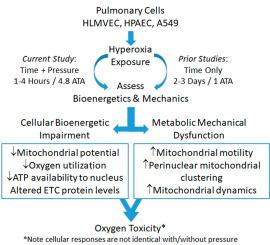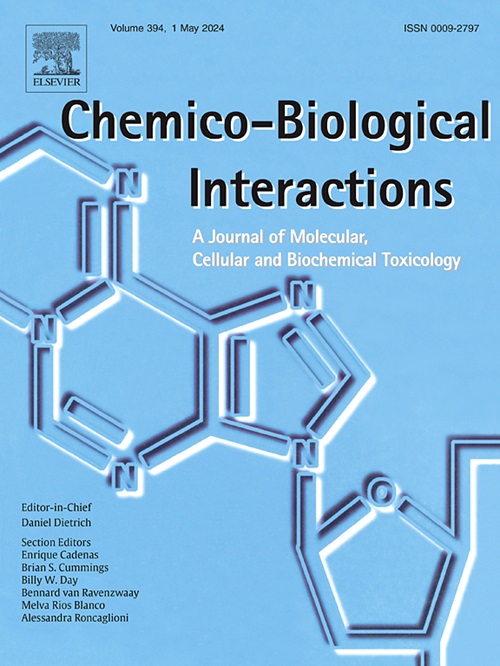高压氧迅速导致人类肺细胞的细胞内生物能失调
IF 4.7
2区 医学
Q1 BIOCHEMISTRY & MOLECULAR BIOLOGY
引用次数: 0
摘要
持续数天的高氧暴露会改变肺细胞线粒体的生物能和动态功能,这是氧气毒性的指标。本研究的目的是研究短期高压氧和高氧暴露对诱发氧毒性的影响。将培养的人肺微血管内皮细胞、人肺动脉内皮细胞和 A549 细胞暴露于高压氧条件(4.8 ATA)下的高氧(∼ 5%二氧化碳当量,平衡氧气)中 1 小时和 4 小时。然后对线粒体动力学、内膜电位、线粒体呼吸、生物能的细胞内分布和呼吸复合蛋白水平进行量化。暴露导致线粒体运动发生改变、呼吸参数出现不均匀性、内膜电位丧失以及与 ATP 相关的呼吸在细胞内的分布发生变化。呼吸复合蛋白水平也发生了变化。高氧暴露与高压氧条件相结合,迅速导致肺细胞线粒体动力学和生物能发生变化。这些变化与之前已知的仅因长时间暴露于高氧环境而导致肺氧中毒的情况一致。这些研究结果表明,在同时存在高氧和高压氧条件的环境中,应谨慎对待健康问题。在细胞模型中,高氧和高压氧的协同作用可快速诱导氧毒性,这对于研究氧毒性的机理决定因素、测试可能的治疗方法以及线粒体功能障碍的相关研究都很有用。本文章由计算机程序翻译,如有差异,请以英文原文为准。

Hyperbaric oxygen rapidly produces intracellular bioenergetics dysfunction in human pulmonary cells
Hyperoxic exposure lasting days alters mitochondrial bioenergetic and dynamic functions in pulmonary cells as indices of oxygen toxicity. The aim of this study was to examine effects of short duration hyperbaric and hyperoxic exposures to induce oxygen toxicity similarly. Cultured human lung microvascular endothelial cells, human pulmonary artery endothelial cells and A549 cells were exposed to hyperoxia (∼5 % CO2 equivalent, balance O2) under hyperbaric conditions (4.8 ATA) for 1 and 4 h. Measures of mitochondrial dynamics, inner membrane potential, mitochondrial respiration, the intracellular distribution of bioenergetic capacity and respiration complex protein levels were then quantified. Exposures resulted in altered mitochondrial motility, presence of inhomogeneities in respiration parameters, loss of inner membrane potential, and changes in intracellular partitioning of ATP-linked respiration. Changes in the levels of respiration complex protein levels were also found. The combination of hyperoxic exposure with hyperbaric conditions rapidly produced changes in mitochondrial dynamics and bioenergetics in pulmonary cells. These changes are consistent with the onset of pulmonary oxygen toxicity previously known to result from long duration exposure to hyperoxia alone. These findings suggest health caution is warranted in environmental settings in which both hyperoxic and hyperbaric conditions are present. The synergism of hyperoxia and hyperbaria for rapid induction of oxygen toxicity in cellular models has utility for the study of mechanistic determinants of oxygen toxicity, testing of putative therapeutics, and associated investigations of mitochondrial dysfunction.
求助全文
通过发布文献求助,成功后即可免费获取论文全文。
去求助
来源期刊
CiteScore
7.70
自引率
3.90%
发文量
410
审稿时长
36 days
期刊介绍:
Chemico-Biological Interactions publishes research reports and review articles that examine the molecular, cellular, and/or biochemical basis of toxicologically relevant outcomes. Special emphasis is placed on toxicological mechanisms associated with interactions between chemicals and biological systems. Outcomes may include all traditional endpoints caused by synthetic or naturally occurring chemicals, both in vivo and in vitro. Endpoints of interest include, but are not limited to carcinogenesis, mutagenesis, respiratory toxicology, neurotoxicology, reproductive and developmental toxicology, and immunotoxicology.

 求助内容:
求助内容: 应助结果提醒方式:
应助结果提醒方式:


